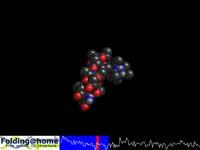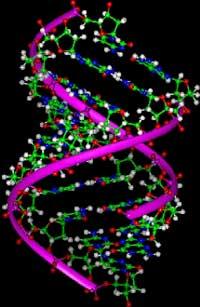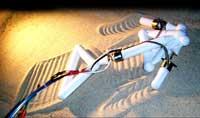Home computers at the service of research
Fightaids@home http://www.fightaidsathome.com

As is known, the HIV-1 protease has a major influence on the reproduction of AIDS retroviruses. The main objective of this program is to analyze what compounds consist of that can reduce their impact. Using the AutoDock computer tool, they investigate the three-dimensional structure of the agents causing the infection. Specifically, the AutoDock serves to study the association of small molecules with the possibility of being three-dimensional protein drugs.
The AIDS virus has a great capacity for change, so all variants must be taken into account. For this reason, it is essential the work of the computers that work together.
Compute Against Cancer http://www.computeagainstcancer.org

This is the first initiative that launched computers online to fight cancer. It was launched at the end of last year. It allows to work with Mac and Windows operating systems, with more than 16,000 computers participating in research.
The main objective of the program is to obtain new anticancer drugs. To do this, cancer cells are analyzed after studying their genetic bases. They also investigate how cancer treatments affect the quality of patients.
Intel-United Devices Cancer Research Project http://www.fere

While the above was the first of the cancer research projects in the network, if you take into account the participation, the most important thing is the United Devices project, with about 460,000 participants. Founded and powered by the Intel IT company, it has the support of the National Cancer Research Foundation of the United States and the University of Oxford.
This project is using the Think program. In short, this program makes three-dimensional models of the molecules to be studied to carry out later tests with them and with proteins. At present, a study of the elements that lead blood to tumors is being carried out, since they are believed to provoke the growth and proliferation of the tumors.
Folding@home http://www.stanford.edu/group/pandegroup/Cosm

This project analyzes the folds of genetic models of proteins. To develop the crease simulation program, a new simulation technique has been developed, which has enabled a representative simulation of the folding of different fractions of proteins and synthetic polymers. However, to be able to work with real proteins, being larger and more complex, a large capacity of calculation is required. Therefore, the work of computers that can work together is essential. It can work with Windows and Linux operating systems and have already launched nearly 17,000 computers.
Genome@home http://genomeathome.stanford.edu
The objective is to design genes capable of forming functional proteins in cells, that is, to produce virtual genes. The promoters of the project consider that this way the functioning of the genes can be better understood. Despite this theoretical objective, in practice new drugs and therapies are sought. Currently around 20,000 computers are working on this project.
Evolution@home http://www.evolutionary-research.org

This is an ambitious project: Deepen the knowledge of all the factors that influence the evolution of species on Earth. The complexity of the objective has led to the creation of numerous sub-projects, with the start-up of different simulators. Each of them will answer only one specific question. This is a future project, as for the moment they have launched a single simulator, the simulator Simulator 005. Their work consists of analyzing how they affect and how they affect genetic transformations in small populations.
Golem@home http://www.demo.cs.brandeis.edu/golem
In this project, studies are carried out on the design of robots and robots. Through simulations, artificial life forms are analyzed to know the bases of real life.
Mars Clicworkers http://clickworkers.arc.nasa.gov

Together with the rest of research projects, this can be special, as more help is needed than computers connected to the network, than computer users who work on the network. This is a search project because the computer user has to mark the Mars craters he sees in the photos that NASA sends home. The help is fundamental for NASA, which has taken many photos from the cover of Mars. To minimize the number of errors, each photo is sent to several people.
According to those responsible for the project, about 30,000 people have already participated, marked more than 1,800,000 craters and a database of 250,000 craters has been created.
Casino 21 http://www.climateprediction.com

The theme of this project is meteorology. And it is that the climatology has a great tradition in the use of super computers, since they have always been used to make predictions and modelling the climate they can simulate. They will be used randomly from real data (as in casinos) to produce climate models. The computer will build three-dimensional models, taking into account various variables that make up the climate, such as rains, temperatures, the behavior of the gases that cause the greenhouse effect, the state of the sea, etc. The main objective is to develop climate models that serve for this century. The project has been announced but there is still no participation, since it is in its beginnings.
Gamma Flux http://www.jansson.net

Program of improvement of the containers and systems of collection of radioactive waste used. The radiation-emitting containers are simulated to calculate the amount of gamma radiation coming out of the containers. Logically, in this process they have much to see, among other things, the shape, dimensions and structure of the container.
Particle Physics Data Grid http://www.cacr.caltech.edu/ppdg
Its objective is to perform particle physics studies using the distributed computer calculation. The main global organizations will participate in the matter of particle physics and will be launched soon.
These are some of the most important projects that are currently being developed in network research. There are other important ones like the aforementioned Seti@home or Folderol itself, but also smaller ones: Gimps Project, Distributed.net Project, Mindpixel Project, ForkMarkets Project, etc. Some have time in the network, others are almost new, some have great objectives, others are simpler… the network connects the computers of each of us.
Published in 7K
Buletina
Bidali zure helbide elektronikoa eta jaso asteroko buletina zure sarrera-ontzian











